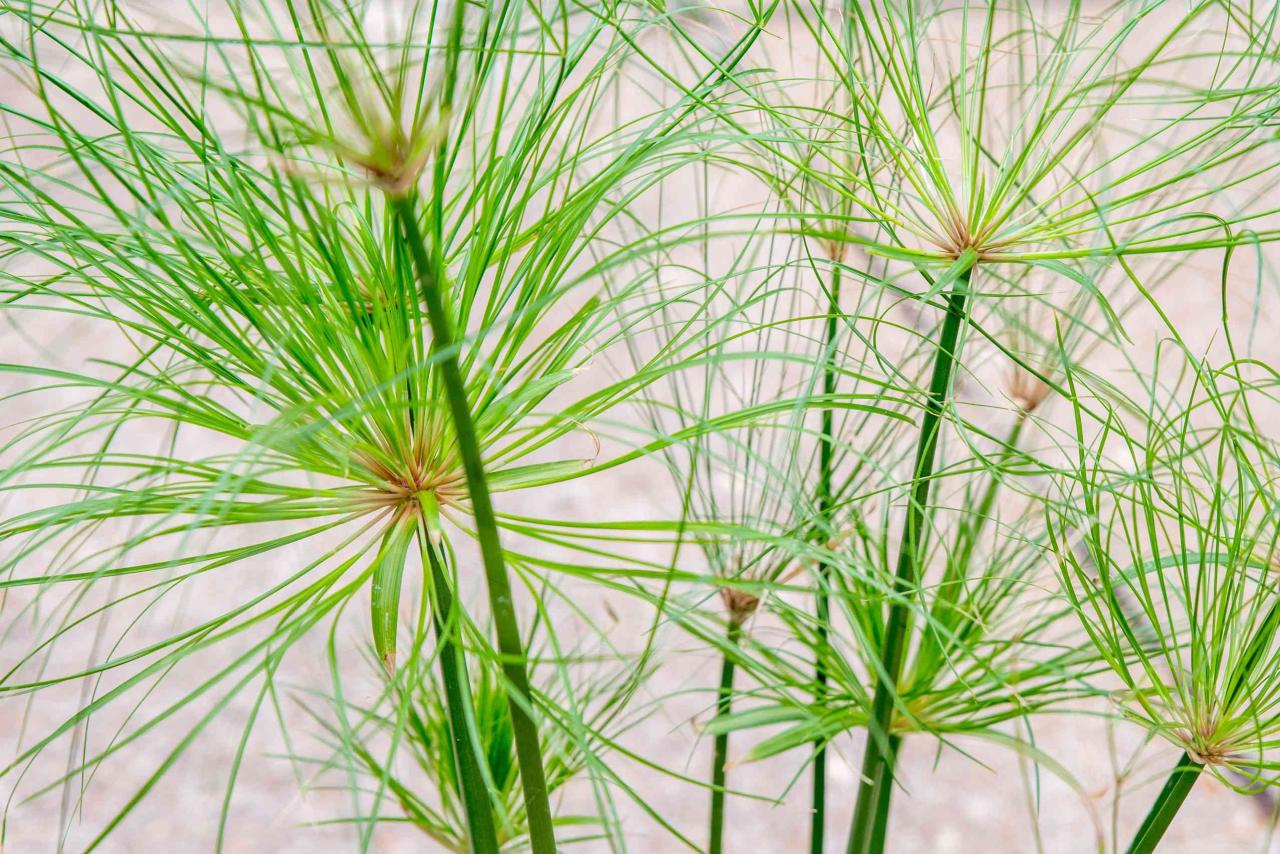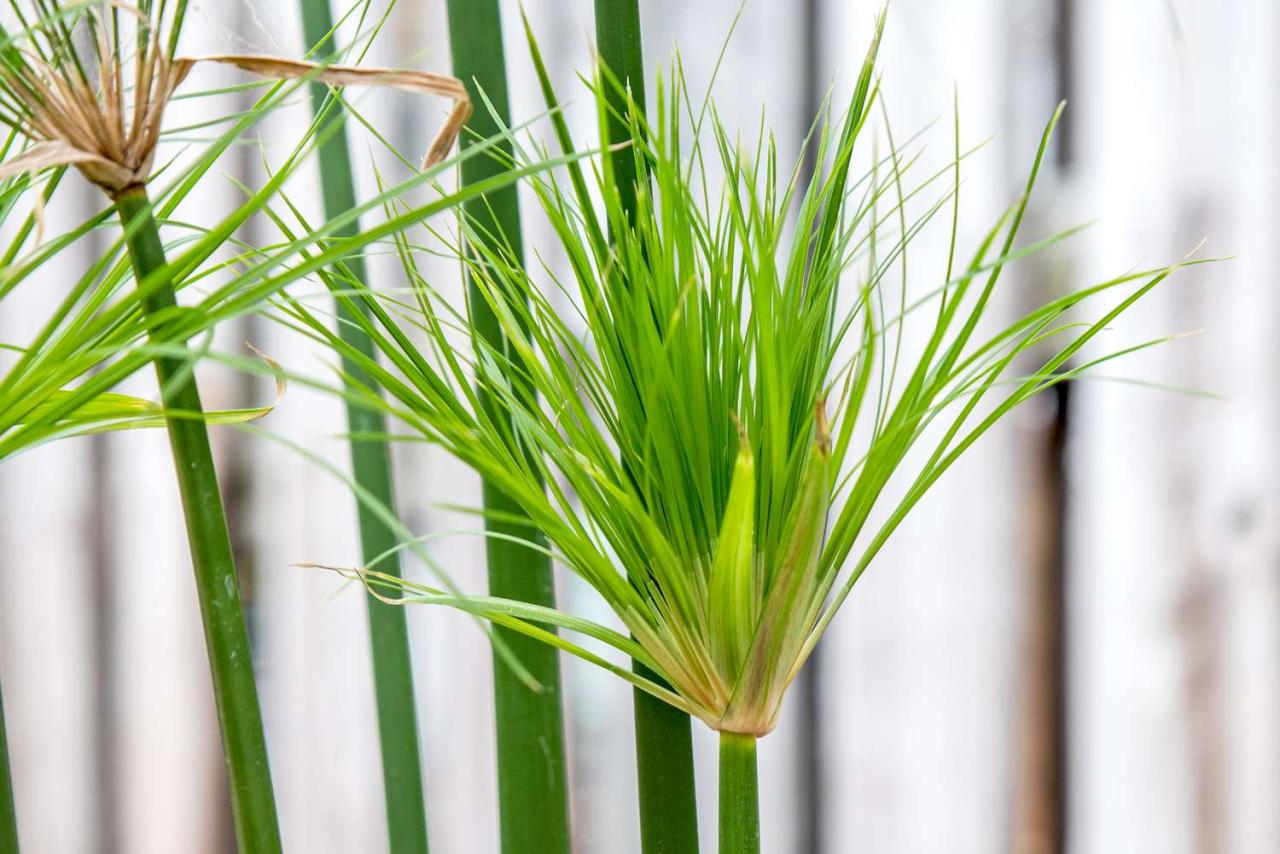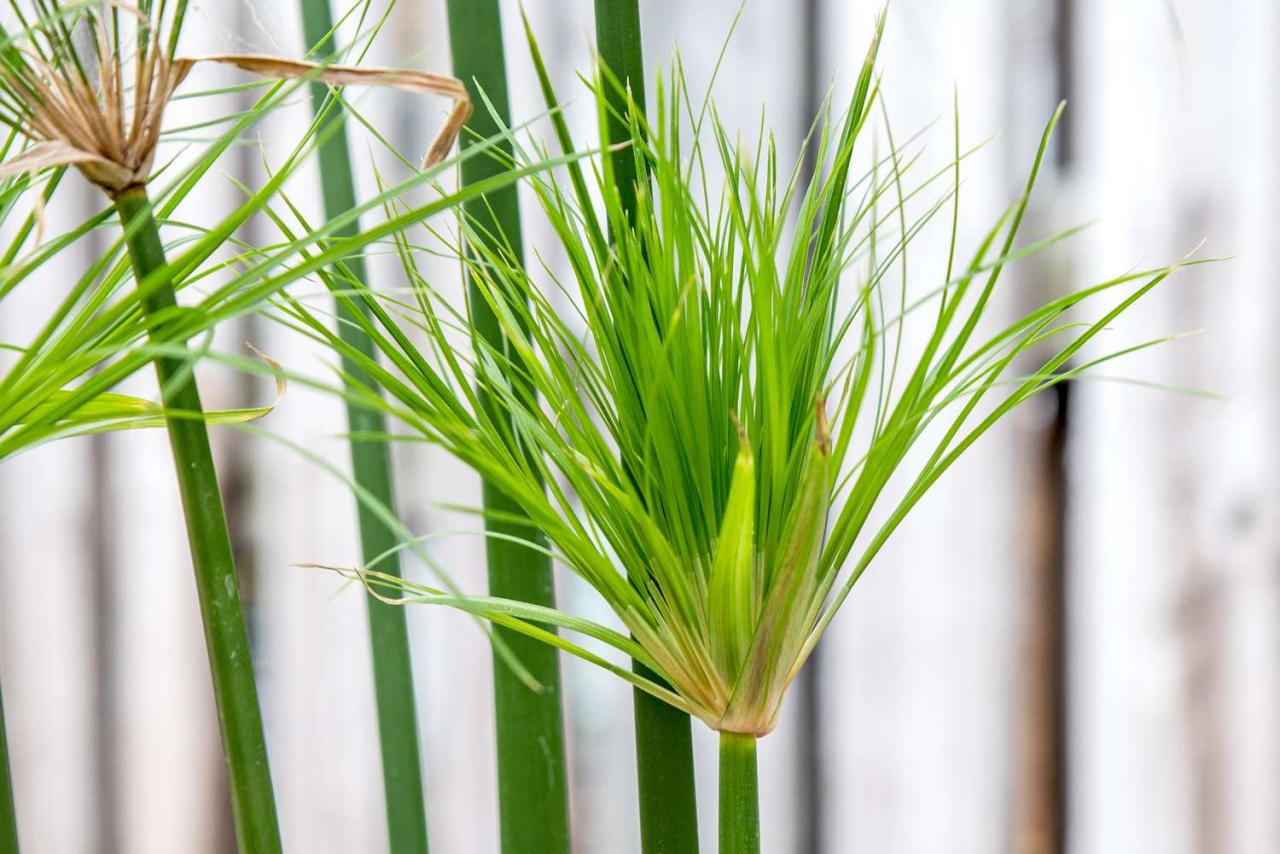Papyrus Plant Care 101: Tips for Growing and Maintaining This Stunning Herb – Dive into the world of papyrus plants, where ancient history meets modern-day gardening. These majestic plants, known for their striking architectural features and historical significance, can grace your home or garden with their unique beauty.
Learn how to cultivate these fascinating plants, from selecting the right species to mastering the art of propagation and care. Discover the secrets to nurturing healthy, thriving papyrus plants that will transform your space into a captivating oasis.
Papyrus plants, with their distinctive tall, reed-like stems and feathery plumes, offer a captivating blend of beauty and practicality. From their ancient use in papermaking to their modern role as air purifiers and decorative elements, these versatile plants have a rich history and a place in contemporary homes and gardens.
Whether you’re a seasoned gardener or a curious beginner, this guide will equip you with the knowledge and techniques to cultivate these fascinating plants and enjoy their unique charm.
Introduction to Papyrus Plants

Papyrus plants, scientifically known as Cyperus papyrus, are remarkable aquatic herbs that hold a rich history and cultural significance. Their distinctive feathery plumes and tall, slender stalks have captivated civilizations for millennia, leaving an enduring mark on art, writing, and even architecture.
Historical Significance and Cultural Relevance
Papyrus plants played a pivotal role in ancient Egyptian civilization. Their stems, when processed into sheets, provided the primary writing material for hieroglyphics, records, and religious texts. These “papyrus scrolls” served as the foundation for preserving knowledge, literature, and historical accounts.
The plant’s versatility extended beyond writing, with its stems also being used for building materials, mats, sandals, and even boats.
Natural Habitat and Adaptability
Papyrus plants thrive in wetlands, marshes, and along the banks of rivers and lakes. Their natural habitat is characterized by moist, sunny conditions and nutrient-rich water. These plants are native to Africa, particularly in the Nile River valley, and have since spread to other tropical and subtropical regions.
They are adaptable to various environments, but require consistent moisture and sunlight to flourish.
Benefits of Growing Papyrus Plants
Cultivating papyrus plants offers a unique blend of aesthetic appeal, environmental benefits, and creative possibilities.
Aesthetic Appeal
Papyrus plants possess a captivating beauty that adds a touch of tropical elegance to any setting. Their feathery plumes create a graceful, airy presence, while their tall stalks add vertical interest to landscapes. The plant’s vibrant green foliage provides a refreshing contrast against other plants and creates a soothing ambiance.
Air-Purifying Qualities
Like many other plants, papyrus plants contribute to improving indoor air quality. They effectively absorb pollutants and release oxygen, creating a healthier and more refreshing environment. Their ability to thrive in humid conditions makes them ideal for bathrooms and kitchens, where moisture levels can be higher.
Crafting Possibilities
The versatility of papyrus plants extends to crafting. Their stems can be used to create a range of handmade items, such as baskets, mats, paper, and even decorative elements for home décor. These crafts not only showcase the plant’s natural beauty but also offer a unique and sustainable way to incorporate its qualities into everyday life.
Choosing the Right Papyrus Plant
Selecting the right papyrus plant is crucial for successful cultivation. The choice depends on the available space, desired aesthetic, and the specific growing conditions. There are several species of papyrus plants, each with unique characteristics.
Papyrus Plant Species, Papyrus Plant Care 101: Tips for Growing and Maintaining This Stunning Herb
Papyrus plants belong to the Cyperus genus. While there are numerous species, only a few are commonly cultivated as ornamental plants. Here’s a summary of some popular species:
- Cyperus papyrus: This is the most popular species, known for its tall, graceful stalks and feathery plumes. It can grow up to 10 feet tall and wide, making it suitable for large gardens or water features. It prefers full sun and consistently moist soil.
- Cyperus alternifolius: This species is more compact, reaching heights of 3 to 4 feet. It has umbrella-like clusters of leaves at the top of the stalks. This makes it a good choice for smaller gardens, containers, or indoor settings. It tolerates partial shade and can even thrive in a bog garden.
- Cyperus involucratus: This species is a dwarf papyrus, typically reaching a height of 1 to 2 feet. It is a good choice for small containers or as a groundcover. It prefers moist soil and partial shade.
Selecting the Best Papyrus Plant
Choosing the right papyrus plant depends on several factors:
- Available space: Consider the size and growth habit of the chosen species. If you have limited space, choose a smaller species like Cyperus alternifolius or Cyperus involucratus. For larger gardens, Cyperus papyrus is a good option.
- Desired aesthetic: Different species have different appearances. Cyperus papyrus has a dramatic, tropical look, while Cyperus alternifolius is more delicate and graceful. Cyperus involucratus offers a compact, groundcover-like appearance. Choose the species that best complements your landscape or design.
- Environmental conditions: Each species has different light and water requirements. Ensure the chosen species can thrive in your specific climate and growing conditions. For example, Cyperus papyrus requires full sun and consistently moist soil, while Cyperus alternifolius can tolerate partial shade.
Importance of Choosing a Healthy Plant
It is crucial to select a healthy and vigorous papyrus plant from a reputable source. This ensures a successful start for your plant and reduces the risk of disease or pests. Look for a plant with lush, green foliage, no signs of disease or pests, and a strong root system.
Planting and Propagation
Papyrus plants thrive in warm, humid environments and prefer moist soil. The right planting conditions and propagation techniques are crucial for their healthy growth and development.
Planting Papyrus Plants
Papyrus plants can be planted in containers or directly in the ground, depending on your climate and growing conditions.
- Soil:Papyrus plants prefer rich, well-draining soil. A mixture of peat moss, compost, and perlite is ideal. The soil should be kept consistently moist but not waterlogged.
- Sunlight Exposure:Papyrus plants need full sun to partial shade. They can tolerate some shade, but they will grow best in a location that receives at least 6 hours of sunlight per day.
- Water Requirements:Papyrus plants are water-loving and need consistent moisture. Water them deeply and regularly, allowing the top inch of soil to dry out between waterings. During hot weather, you may need to water them more frequently.
Planting in Containers
- Choose a container:Select a container that is at least 12 inches in diameter and has drainage holes. Larger containers will provide more space for the papyrus plant to grow.
- Fill the container with soil:Fill the container with a mixture of peat moss, compost, and perlite. Leave about 2 inches of space at the top of the container.
- Plant the papyrus:Carefully remove the papyrus plant from its nursery pot and place it in the center of the container. Backfill the container with soil, making sure to cover the roots completely.
- Water the plant:Water the plant thoroughly after planting.
Planting in the Ground
- Choose a location:Select a location that receives at least 6 hours of sunlight per day. The soil should be well-drained and rich in organic matter.
- Prepare the soil:Amend the soil with compost or peat moss to improve drainage and fertility. Dig a hole that is twice the width and depth of the papyrus plant’s root ball.
- Plant the papyrus:Carefully remove the papyrus plant from its nursery pot and place it in the hole. Backfill the hole with soil, making sure to cover the roots completely.
- Water the plant:Water the plant thoroughly after planting.
Propagation
Papyrus plants can be propagated through division or seed germination.
Division
- Choose a healthy plant:Select a mature papyrus plant that has multiple stems.
- Divide the plant:Carefully dig up the plant and gently separate the clumps into smaller divisions. Each division should have at least one stem and a good root system.
- Replant the divisions:Plant the divisions in containers or directly in the ground, following the planting instructions above.
Seed Germination
- Start seeds indoors:Sow papyrus seeds in a seed tray filled with a moist seed-starting mix. Cover the seeds with a thin layer of soil and keep the soil moist.
- Provide warmth:Keep the seed tray in a warm location with temperatures between 70-80 degrees Fahrenheit.
- Maintain moisture:Keep the soil moist, but not waterlogged. Use a spray bottle to mist the soil as needed.
- Thin seedlings:Once the seedlings have a few true leaves, thin them out to give each seedling adequate space to grow.
- Transplant seedlings:Once the seedlings are a few inches tall, they can be transplanted into individual containers or directly into the ground.
Papyrus Plant Care 101
Papyrus plants, with their striking resemblance to ancient scrolls, add a touch of exotic elegance to any indoor or outdoor space. But their graceful presence demands consistent care. Understanding the fundamental principles of papyrus plant care ensures their continued health and vibrant growth.
Watering and Drainage
Adequate watering is crucial for papyrus plants. They thrive in moist environments, mimicking their natural habitat along water bodies. However, overwatering can lead to root rot, a fatal condition for these plants. To maintain the delicate balance between moisture and drainage, here’s a practical guide:
- Water regularly:Papyrus plants require consistent moisture. Allow the top inch of soil to dry slightly between waterings, then thoroughly soak the soil.
- Drainage:Use a pot with drainage holes to prevent waterlogging. A layer of gravel or pebbles at the bottom of the pot can further enhance drainage.
- Avoid standing water:Never allow water to sit in the pot’s saucer. Empty any excess water immediately after watering to prevent root damage.
Fertilizing
Papyrus plants are heavy feeders, requiring regular fertilization to support their lush growth. Providing the right nutrients ensures healthy foliage and vibrant color.
While papyrus plants are known for their striking appearance, they can also be propagated through division, much like the popular ivy plant. If you’re looking for a way to expand your papyrus collection, consider learning how to easily propagate ivy and get more plants for free, as outlined in this comprehensive guide: How to Easily Propagate Ivy and Get More Plants for Free.
Once you’ve mastered the art of propagation, you can apply similar techniques to your papyrus plants, ensuring a flourishing and abundant display of these stunning herbs.
- Fertilize regularly:During the active growing season (spring and summer), fertilize every two weeks with a balanced liquid fertilizer diluted to half strength.
- Avoid over-fertilizing:Excess fertilizer can damage the roots and lead to leaf burn. Always follow the manufacturer’s instructions for dilution and frequency.
- Organic options:Consider using organic fertilizers, such as compost tea or fish emulsion, to provide a slow-release source of nutrients.
Pests and Diseases
While papyrus plants are generally resistant to pests and diseases, they can be susceptible to certain issues. Early detection and appropriate treatment are key to preventing major problems.
- Common Pests:Mealybugs, aphids, and spider mites are common pests that can infest papyrus plants. These insects can be controlled with insecticidal soap or neem oil.
- Disease:Root rot is the most common disease affecting papyrus plants. It occurs due to overwatering and poor drainage. To prevent root rot, ensure proper drainage and avoid overwatering.
- Signs of infestation:Keep a watchful eye for signs of pests, such as sticky residue, discolored leaves, or webbing. Early detection allows for timely intervention and minimizes damage.
Creating a Stunning Papyrus Display
Papyrus plants, with their striking architectural foliage, offer a unique and captivating element to any indoor or outdoor space. Their versatility allows for a wide range of creative display options, from simple elegance to bold and dramatic statements. By understanding the plant’s growth habits and incorporating it into various settings, you can create stunning displays that enhance the beauty of your home or garden.
Displaying Papyrus Plants in Different Settings
The papyrus plant’s adaptable nature makes it suitable for a variety of settings. Here is a table outlining different ways to showcase papyrus plants in indoor, outdoor, and water garden environments:
Setting |
Display Ideas |
Considerations |
|---|---|---|
Indoor |
– Large container on a pedestal or stand
|
– Choose a pot with adequate drainage
|
Outdoor |
– Focal point in a garden bed
|
– Ensure well-drained soil
|
Water Garden |
– Planted directly in the water
|
– Provide ample sunlight
|
Creative Arrangements and Combinations
Papyrus plants can be combined with other plants to create visually appealing arrangements. Here are some ideas for enhancing the visual appeal of papyrus plants:
- Tropical Paradise:Combine papyrus with other tropical plants like ferns, bromeliads, and peace lilies. The contrasting textures and foliage colors create a lush and vibrant display.
- Water Garden Oasis:In a water garden, papyrus can be paired with water lilies, lotus flowers, and other aquatic plants. The tall, upright stems of papyrus create a dramatic contrast against the floating foliage of other aquatic plants.
- Modern Minimalism:For a sleek and modern aesthetic, pair papyrus with succulents, cacti, and other drought-tolerant plants. The minimalist design and bold shapes complement the clean lines of the papyrus plant.
Crafting with Papyrus Plants
Papyrus plants have been used for centuries in crafting projects. The plant’s fibrous stems can be used to make paper, baskets, mats, and other decorative items.
“The ancient Egyptians used papyrus to create scrolls, which were used for writing and recording information. The papyrus plant was also used to make mats, baskets, and other household items.”
Cultivating a papyrus plant is similar to establishing a lush lawn – both require strategic timing and consistent care. Just as the ideal time to sow grass seed for a healthy lawn depends on your climate, When to Sow Grass Seed for a Healthy and Green Lawn: Expert Advice and Tips , so does the best time to plant papyrus.
Understanding the ideal conditions for germination and growth ensures your papyrus thrives and becomes a stunning focal point in your home or garden.
- Papermaking:The stems of the papyrus plant are peeled, soaked, and then pressed together to create sheets of paper. This process is similar to how paper is made from wood pulp, but it involves using natural fibers.
- Basketry:The stems of the papyrus plant can be woven together to create baskets, mats, and other decorative items. This process involves drying the stems and then weaving them into various shapes.
- Decorative Items:The dried stems of the papyrus plant can also be used to create decorative items such as wreaths, centerpieces, and wall art. The natural texture and color of the stems add a unique and rustic touch to any space.
Closure

Cultivating papyrus plants is a rewarding journey that blends historical intrigue with the joy of nurturing nature’s beauty. From understanding their unique needs to creating stunning displays, this guide has provided you with the essential knowledge to embark on this exciting endeavor.
With proper care and attention, your papyrus plants will flourish, transforming your surroundings into a captivating testament to the timeless elegance of these remarkable plants.
FAQ Corner: Papyrus Plant Care 101: Tips For Growing And Maintaining This Stunning Herb
What are the best types of papyrus plants for beginners?
Cyperus papyrus, the most common species, is an excellent choice for beginners due to its adaptability and ease of care. Other beginner-friendly options include Cyperus alternifolius and Cyperus involucratus.
How often should I fertilize my papyrus plant?
Fertilize your papyrus plant every two weeks during the growing season (spring and summer) with a balanced liquid fertilizer diluted to half strength.
Can I grow papyrus plants outdoors in colder climates?
Papyrus plants are generally not cold-hardy and prefer warm temperatures. In colder climates, they can be grown outdoors during the summer months and brought indoors during the winter.
